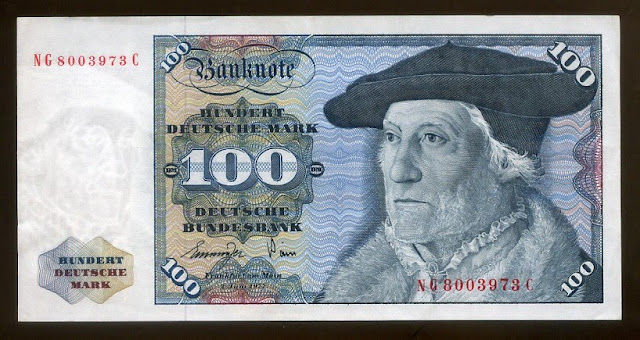 |
| German banknotes 100 Deutsche Mark banknote of 1977, Sebastien Munster. |
 |
| German bank notes 100 DM Deutsche Mark |
German banknotes 100 DM Deutsche Mark banknote 1977, issued by the Deutsche Bundesbank - German Federal Bank
100 Deutsche Mark old German pre-euro bank note.
German banknotes, German mark banknotes, Deutsche Mark, German paper money, German bank notes, Germany banknotes, Germany paper money, Germany bank notes, German currency, German East African banknotes, German Rentenmark.Obverse: Portrait of the Cosmographer Sebastien Munster (1488 – 1552) by Christoph Amberger. Year: 1552. Museum: Staatliche Museen, Berlin, Germany.
Reverse: Eagle with outstretched wings is the embody the German national consciousness.
Germany banknotes - Germany paper money
Deutsche Bundesbank - German Federal Bank
1960-1980 issue
The third series of German mark banknotes was introduced in 1960 by the Bundesbank, depicting neutral symbols, paintings by the German painter Albrecht Dürer, and buildings. There were 5 Deutsche Mark, 10 Deutsche Mark, 20 Deutsche Mark, 50 Deutsche Mark, 100 Deutsche Mark, 500 Deutsche Mark and 1000 Mark denominations.
5 Deutsche Mark 10 Deutsche Mark 20 Deutsche Mark 50 Deutsche Mark
100 Deutsche Mark 500 Deutsche Mark 1000 Deutsche Mark
100 Deutsche Mark 500 Deutsche Mark 1000 Deutsche Mark
Sebastian Münster
Sebastian Münster (20 January 1488 – 26 May 1552), was a German cartographer, cosmographer, and a Christian Hebraist scholar. His work, the Cosmographia from 1544, was the earliest German description of the world.
Deutsche Mark
The Deutsche Mark (German mark, abbreviated "DM") was the official currency of West Germany (1948–1990) and unified Germany (1990–2002) until the adoption of the euro in 2002. It is commonly called the "Deutschmark" in English but not in German. Germans often say "Mark" or "D-Mark". It was first issued under Allied occupation in 1948 replacing the Reichsmark, and served as the Federal Republic of Germany's official currency from its founding the following year until 1999, when the mark was replaced by the euro; its coins and banknotes remained in circulation, defined in terms of euros, until the introduction of euro notes and coins in early 2002. The Deutsche Mark ceased to be legal tender immediately upon the introduction of the euro—in contrast to the other Eurozone nations, where the euro and legacy currency circulated side by side for up to two months. Mark coins and banknotes continued to be accepted as valid forms of payment in Germany until 28 February 2002.
The Deutsche Bundesbank has guaranteed that all German marks in cash form may be changed into euros indefinitely, and one may do so at any branch of the Bundesbank in Germany. Banknotes can even be sent to the bank by mail.
On 31 December 1998, the Council of the European Union fixed the irrevocable exchange rate, effective 1 January 1999, for German mark to euros as DM 1.95583 = €1.
One Deutsche Mark was divided into 100 Pfennig.
The third series of German mark banknotes was introduced in 1960 by the Bundesbank, depicting neutral symbols, paintings by the German painter Albrecht Dürer, and buildings. There were 5 Deutsche Mark, 10 Deutsche Mark, 20 Deutsche Mark, 50 Deutsche Mark, 100 Deutsche Mark, 500 Deutsche Mark and 1000 Mark denominations.